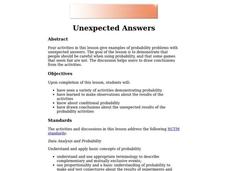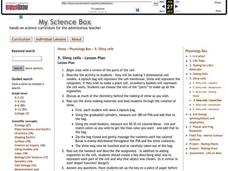Curated OER
Map Studies - Estimate And Measure Distance
First graders explore estimating and measuring distances. They analyze and discuss a map of New York State, make estimations, measure distances using yarn, and calculate total distances between cities on the map.
Curated OER
Unexpected Answers
Students explore and complete a variety of activities demonstration probability. They make observations about the results of the activities. Students complete and discuss conditional probability. Also, students draw conclusions about...
Curated OER
Spiders
First graders complete a variety of center activities to study spider characteristics and facts. They solve math problems, identify spider body parts, and study vocabulary words to use in creative writing about spiders.
Curated OER
The Truth About Triangles and Squares
Fourth graders investigate the patterns associated with both triangular and square numbers. They use counters as manipulatives to depict the numbers as needed but focus on problem solving using mental math techniques.
Curated OER
Buttons and Bears
Students read the problem and then identify the important information in the problem and highlight. They then brainstorm for ways to solve the problem by drawing a picture and working in pairs.
Curated OER
Slimy cells
Students study the parts of a cell. In this chemistry instructional activity students complete an activity in which they make as much slime as they want.
Curated OER
Sampling Distribution of Sample Means
Learners collect data and crate a distribution sample. In this statistics lesson, students compare and contrast their collected data. This assignment requires the learners to be comfortable with navigating the internet.
Curated OER
Budgeting 101
Students identify various sources of income and discern between needs and wants as they also learn to create a personal budget. In this personal budget instructional activity, student understand financial scenarios as they relate...
ReadWriteThink
Read Write Think: Using Picture Books to Teach Setting Development
Contains plans for two or three lessons that teach about setting using picture books as models. In addition to objectives and standards, this instructional plan contains links to sites used in the lessons as well as assessment and...
Auburn University
Auburn University: Teaching Letter Recognition
How can you teach your students letter recognition? This site offers insight into this necessary pre-reading skill set. Come and explore this informative resource.
TeachEngineering
Teach Engineering: Engineer a Sneaker
The goal is for students to understand the basics of engineering that go into the design of a sneaker. The bottom or sole of a sneaker provides support, cushioning, and traction. In addition the sole is flexible and can have some fashion...
Texas Instruments
Texas Instruments: Introduction to Some Algebra Concelpts Using Cas
This series of activities provides an introduction to some Algebra concelpts using CAS. The activities start with Algebra tiles and CAS. Patterning is modelled for the students so that they can construct the knowledge rather than be...
Can Teach
Can Teach: Math Centers
This page offers a variety of math center ideas for general math and geometry. Instructions on setting up the center are not provided for most ideas, however, those lacking instructions are pretty self-evident.
Math Playground
Math Playground: Thinking Blocks
This lesson teaches students how to use colored blocks to model word problems. There are several sets of problems each for addition / subtraction, multiplication / division, and ratio word problems.
TeachEngineering
Teach Engineering: Forces and Graphing
This activity can be used to explore forces acting on an object, to practice graphing experimental data, and/or to introduce the algebra concepts of slope and intercept of a line. A wooden 2x4 beam is set on top of two scales. Students...
Other
University of Edinburgh: Glossary of Introductory Computer Graphics Terms
This website, from the University of Edinburgh, provides a lengthy glossary of computer graphics terms written by Olin Lathrop, author of "The Way Computer Graphics Work". This site provides simple definitions of basic terms; no graphics...















